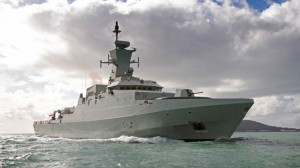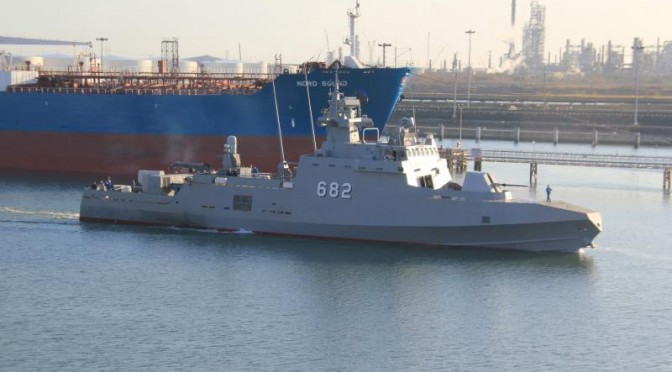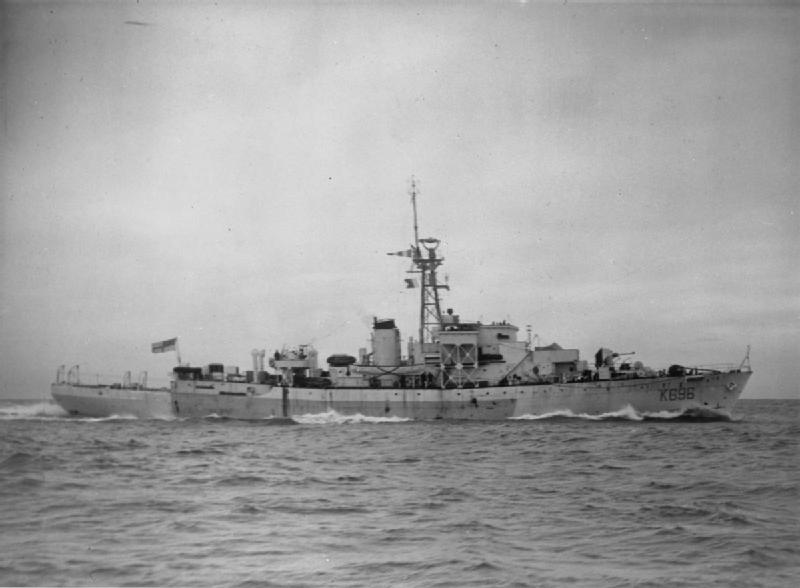
By Paul Pryce
The Persian Gulf has long been a waterway of strategic importance. On average, $105 billion worth of goods are exchanged between Iran and the Gulf states each year. In addition, approximately 20% of the world’s petroleum traverses the Strait of Hormuz, a narrow passage between the Persian Gulf and the open seas. Clearly, ensuring the security of this body of water is vital to the health of the global economy. In this respect, the US Navy’s Fifth Fleet fulfills a significant role, as does Combined Task Force 152, a multinational contingent patrolling the Persian Gulf since 2004. But what role do regional navies play in securing these same waterways?
To address this question, it is worthwhile examining the corvettes employed by the Islamic Republic of Iran, the Republic of Iraq, and the countries of the Gulf Cooperation Council. These smaller, lighter vessels are sufficiently maneuverable to navigate the narrow waterways that characterize the region. Corvettes are also for the most part the heaviest vessels operated by the region’s maritime forces. Comparing the corvettes can provide valuable insight into the current and future balance of naval power in the Persian Gulf.
The Royal Navy of Oman (RNO) is representative of the rapid development taking place in the region’s maritime forces. For several years, the RNO has depended largely on its two Qahir-class corvettes (1,450 tons), which have been in operation since 1996. Beyond this pair of vessels, the RNO operated a single patrol ship, Al-Mubrukah; having begun life as a royal yacht, it was converted to a training ship for a time, then was re-designated to patrol Omani waters in 1997. However, the RNO has commissioned three Khareef-class corvettes (2,660 tons) from BAE Systems, based in Portsmouth, UK. The first of these vessels, Al-Shamikh, was delivered in October 2013. The remaining two Khareef-class corvettes, Al-Rahmani and Al-Rasikh, are expected in 2014 and 2015 respectively.
The United Arab Emirates Navy also has ambitions to expand its capabilities, though these plans are at an earlier stage. Purchases have been made for six Baynunah-class missile corvettes (915 tons) to replace the country’s six aging Ardhana-class patrol craft (175 tons), which have been in operation since 1976. While one of the new vessels have been completed, the remaining five are not expected for several years due to the relative inexperience of Abu Dhabi Shipbuilding, the local shipbuilder. Even so, the shipbuilder has expressed its hopes to secure further orders of this class for the Kuwaiti and Saudi maritime forces. Aside from the expected Baynunah-class vessels, the UAE’s complement of corvettes is currently comprised of three Abu Dhabi-class corvettes (1,650 tons) and two Muray Jib-class corvettes (630 tons). The former were acquired as recently as 2011, produced by the Italian shipyard Fincantieri. The latter were produced by Germany’s Lürssen in 1990-1991.
The Qatari Navy is currently considering the acquisition of its own corvettes. For the time being, the country has relied primarily on smaller patrol vessels. Its most substantial vessels are four Vita-class fast attack craft (480 tons) and three Combattante III fast attack craft (430 tons). Officials have proposed bolstering the Qatari Navy’s capabilities with the addition of four corvettes, and the favoured option appears to be Damen Schelde Naval Shipbuilding’s Sigma-class corvette (1,690 tons). Several vessels of this design have been in service with the Indonesian Navy and the Royal Moroccan Navy since 2009, with an additional four having recently been purchased by the Vietnamese military. Whether Qatar will follow through with this purchase remains to be seen, but it would certainly enhance the capabilities of the Qatari Navy and the country’s position in the region.
The Kuwaiti Navy and the Royal Bahrain Naval Force are two notable exceptions to the trend of modernization and expansion in the region. The Kuwaiti Naval Force possesses a limited number of vessels, the most substantial of which is a single Al-Estqlaal-class fast attack craft (410 tons) and commissioned in 1983. The remainder of the Kuwaiti fleet consists of nine fast attack craft (250 tons) and various support vessels. There are no plans for Kuwait to acquire a corvette-like vessel in the near future; much of the budget for the Kuwaiti Naval Force has been directed toward the purchase of several landing craft. Meanwhile, Bahrain is experiencing a corvette-sized gap in its fleet. The flagship of the Royal Bahrain Naval Force is an Oliver Perry-class frigate (4,100 tons), which first entered into service with the United States Navy in 1981 and was subsequently transferred to Bahrain as a gift in 1996. Beyond this, Bahrain also operates two Al-Manama class corvettes (630 tons) and four Ahmed Al-Fateh class missile boats (260 tons), all of which were acquired from the German manufacturer Lürssen in the 1980s.
An unknown quality in the region’s maritime affairs is the future of the Royal Saudi Navy. While Saudi Arabia is certainly a leader among the navies of the Gulf Cooperation Council, there are few details available regarding the plans for this country’s maritime forces. There are some indications that Saudi Arabia was offered a package by the United States Navy, consisting of two destroyers and an undisclosed number of Littoral Combat Ships. Whether this package was accepted is unclear. It seems that Lockheed Martin initially offered eight Littoral Combat Ships for the express purpose of joining the Saudi fleet in the Persian Gulf, but again little is known as to how negotiations proceeded – if at all.
The current array of vessels in service with the Royal Saudi Navy, however, is well known. Three Al-Riyadh class frigates (4,700 tons), which are essentially modified La Fayette-class frigates acquired from the French Navy, have been in service since 2002-2003. An additional four Al-Madinah class frigates (2,600 tons) were produced in France but have been in service since 1985-1986. Also aged, four Badr-class corvettes (1,040 tons) have been in service since 1981-1983. While this represents an ample contingent in comparison to the smaller Gulf states, it must also be noted that the Royal Saudi Navy has its forces split between the Red Sea and the Persian Gulf.
The situation of the Iraqi Navy remains rather problematic. While once an impressive force in its own right, the Iraqi Navy was almost entirely destroyed during the Gulf War of 1991. Attempts to acquire four Lupo-class frigates (3,000 tons) and six Assad-class corvettes (675 tons) failed when Iraq became the subject of an international arms embargo shortly before the Gulf War and the completion of the vessels. As such, the Iraqi Navy was not rebuilt and therefore did not play a significant role during the 2003 invasion of Iraq. Presently, the only combat vessels operated by the Iraqi Navy are four Saettia MK4 class off-shore patrol vessels (390 tons). Iraq has especially narrow sea access, limited mostly to the ports of Umm-Qasr and Al-Faw. Accordingly, Iraqi authorities have sought to limit maritime forces to light patrol boats, which are chiefly tasked with patrolling coastal waters and protecting off-shore oil platforms. In short, Iraq is no longer a significant contributor to the security of the Persian Gulf.
In contrast to its troubled neighbour, the Islamic Republic of Iran Navy (IRIN) maintains one of the most substantial fleets in the region and is working to rapidly expand its capabilities. Furthermore, much of IRIN consists of corvettes, though it refers to most of these as destroyers. Three Alvand-class vessels (1,540 tons) are the mainstay of Iran’s presence in the Persian Gulf, though these have been in operation since 1971-1972. The Moudge-class ‘destroyer’ (1,500 tons) is being introduced to serve alongside these older counterparts. One Moudge-class vessel entered service in the Persian Gulf in 2010, while a second entered service in the Caspian Sea in early 2013. Another four vessels of this class are currently being built and delivery is expected soon. Unfortunately, much of the Moudge-class’ capabilities are not publicly available at this time, though it has been noted that the vessels are largely the result of Iranian reverse-engineering of the Alvand-class.
The Sahand-class (2,000 tons), based at least in part on the design of the Moudge-class ‘destroyer’ (and thus the Alvand-class by extension) is also currently under construction. Once again, not much is known of the vessel’s capabilities, but official announcements indicate the vessel currently under construction will be patrolling the Strait of Hormuz and can be equipped with Chinese-designed C-802 anti-ship missiles. Beyond the aforementioned Iranian destroyers, a Bayandor-class patrol frigate (1,135 tons) was launched after a refit in June 2013. An additional Bayandor-class vessel and Hamzeh-class corvette are in operation, though both have been in operation since 1964-1965 and the latter is deployed in the Caspian Sea. Less relevant to the topic of corvettes but still worth noting in any discussion of maritime security in the Persian Gulf, IRIN has accrued a fleet of submarines, missile boats, and minelayers, which could be employed to significantly inhibit traffic through the Strait of Hormuz.
In surveying the corvettes and corvette-like vessels of the Persian Gulf, several regional trends can be identified. Iran has emerged as the most ambitious modernizer, rapidly developing its maritime forces. Some of its newer vessels, namely the Sahand-class frigate, are explicitly intended to exert a stronger Iranian influence in the Strait of Hormuz. Interestingly, the Sahand-class frigate is also named in memory of an earlier Iranian frigate sunk by the US Navy during Operation Praying Mantis in 1988. The Moudge and Sahand-class frigates also demonstrate a shift in focus toward domestic shipbuilding. Yet the distribution of newer IRIN vessels seems to indicate that the Iranian regime is as concerned about the Caspian Sea as it is about the Persian Gulf; determining the intended destination of the remaining four Moudge-class frigates may offer some insight into Iran’s future strategic priorities.
The countries of the Gulf Cooperation Council have been slower to develop or expand upon their naval forces. Oman, the UAE, and Qatar are actively seeking corvettes but it will still be several years before their respective plans for modernization can be realized. Bahrain and Kuwait are complacent on corvettes, while Saudi Arabia has apparently limited its own plans to whatever package the United States offers. That the Gulf states have not sought to keep up with the expansion of IRIN may in part be due to a security dependence on the US Navy’s Fifth Fleet, as well as multinational forces like Combined Task Force 152. This dependence has been exacerbated by the sustained downfall of Iraq since 1991 as a counterbalance for Iran in the region.
The strategic makeup of the Persian Gulf aside, the next few years in the region will be interesting for corvette enthusiasts. Whether it is the revelation of the Royal Saudi Navy’s package with the US Navy and Lockheed Martin, the unveiling of Iran’s Sahand-class frigate’s capabilities or the final choice of the Qatari Navy’s corvette, there will be plenty to keep everyone on their toes.
Paul Pryce is a Junior Research Fellow at the Atlantic Council of Canada. With degrees in political science from universities in both Canada and Estonia, he has previously worked in conflict resolution as a Research Fellow with the OSCE Parliamentary Assembly. His research interests include African security issues and NATO-Russia relations.



















